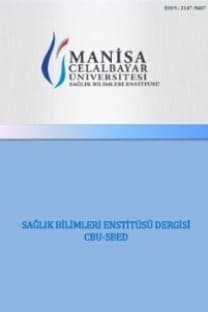Son Sınıf İlk ve Acil Yardım Programı Öğrencilerinin Eğitim Düzeyleri ve Yeterlilik Algı Durumlarının Belirlenmesi
Determining the Education Levels and Proficiency Perception Status of the last class First and Emergency Aid Program Students
___
- 1. Ekşi, A, Kitlesel Olaylarda Hastane Öncesi Acil Sağlık Hizmetleri, Kitapana Basım Yayın, Ankara, 2015; ss 6.
- 2. Barnard, E.B.G, Sandbach, D.D, Nicholls, T.L, Wilson, A.W, Ercole A, Prehospital determinants of successful resuscitation after traumatic and non-traumatic out-of-hospital cardiac arrest, Emergency Medicine Journal, 2019, 36(6), 333-339.
- 3. Reynolds, T.A, Sawe, H, Rubiano, A.M, Do Shin, S, Wallis, L, Mock, C.N, Strengthening health systems to provide emergency care. In: T. Jamison D, Gelband H, Horton S, Jha P, Laxminarayan R, N. Mock C, Nugent R (ed) Disease Control Priorities: Improving Health and Reducing Poverty, 3rd edn. Washington, USA, 2018, pp 248- 249.
- 4.Yıldırım, D, Sarı E, Gündüz, S, Yolcu, S, Paramedik Eğitiminin Dünü ve Bugünü, Smyrna Tıp Dergisi, 2014, 3(1), 51-53.
- 5.Çelikli, S, Kuruluştan Bugüne Paramedik Eğitiminde Standardizasyon Çabaları Ve Kırılma Noktaları, Hastane Öncesi Dergisi, 2016, 1(2), 39-54.
- 6. Aminizadeh, M, Comparing the effects of two different educational methods on clinical skills of emergency intermediate technician: A quasi-experimental research, Journal of Education and Health Promotion, 2019, 8(1), 54.
- 7. Ohbe, H, Isogai, S, Nakajima, M, Jo, T, Matsui H, Fushimi, K, Yasunaga, H, Physician‐manned prehospital emergency care in tertiary emergency centers in Japan, Acute Medicine & Surgery, 2019, 6(2), 165-172.
- 8. Tosun, U, Kızılkan, Ç, Kılıç, S, Özer, M, Yıldıran, N, Yeni Mezun Paramediklerin İlk ve Acil Yardım Teorik/Uygulamalı Eğitim Düzeyi ve Yeterlilik Algıları, TAF Preventive Medicine Bulletin, 2009, 8(4), 291-296.
- 9. Gürbüz, P, Yetiş, G, Çırak, Z.D, İlk Ve Acil Yardım Programı Öğrencilerinin Mesleki Uygulamaları Yapma Ve Yeterli Hissetme Durumlarının Belirlenmesi, İnönü Üniversitesi Sağlık Hizmetleri Meslek Yüksekokulu Dergisi, 2019, 7(2), 170-177.
- 10. Mercan, N.C, Paramedik Eğitimi Uygulama Alanlarında Yaşanan Sorunlar Çalıştayı Sonuç Raporu, Hastane Öncesi Dergisi, 2017, 2(2), 127-134 .
- 11. Yüksel, A, Sağlık Hizmetleri Meslek Yüksekokulu Öğrencilerinin Uygulamalı Derslere İlişkin Görüşleri, Journal of Health Services and Education, 2018, 2(2), 72-77.
- 12. Akbaba, Ö, Tercan, B, Tarsuslu, S, Uzuner, Yurt, S, İlk ve Acil Yardım Laboratuvarında Uygulanan Simülasyon Eğitiminin Öğrencilerin Temel Beceri Düzeyine Etkisi, Journal of Health Services and Education, 2019, 3(2), 45-51.
- ISSN: 2147-9607
- Yayın Aralığı: 4
- Başlangıç: 2014
- Yayıncı: Manisa Celal Bayar Üniversitesi Sağlık Bilimleri Enstitüsü
Ali Bestami KEPEKÇİ, Bedrettin ÇİNPOLAT, Perihan EREN BANA
Davranış Bağımlılığına Sahip Müracaatçılara Yönelik Sosyal Hizmet Uygulamaları Üzerine Bir Tartışma
Melek ZUBAROĞLU YANARDAĞ, Mehmet BİLGE, Umut YANARDAĞ
Davranış Bağımlılığı ve Sosyal Hizmet Uygulamaları Üzerine Bir İnceleme
Melek ZUBAROĞLU YANARDAĞ, Mehmet, Umut YANARDAĞ
Nadir Karaciğer Metastazı Bulunan Nöroendokrin Tümör Olgusu
Tahir BURAN, Elmas KASAP, Gamze GÖKSEL ÖZTÜRK, Burcu ALMACAN İNCE
Mide Kanseri’nde Erken Tanı Hayat Kurtarır
Kadın Bireylerde Besin Bağımlılığının Değerlendirilmesi
Türkiye'nin Leishmaniasis Araştırmalarına Katkısı (1980-2019): Bibliyometrik Analiz
Serhat SİREKBASAN, Tuğba GÜRKÖK TAN
Melek MEMOĞLU, Songül ÖZYURT, Neslihan ÖZÇELİK, Aziz GÜMÜŞ, Ünal ŞAHİN
“Kanıta Dayalı Hemşirelik”: Hemşirelik Öğrencilerinin Bilgi, Tutum ve Davranışları
